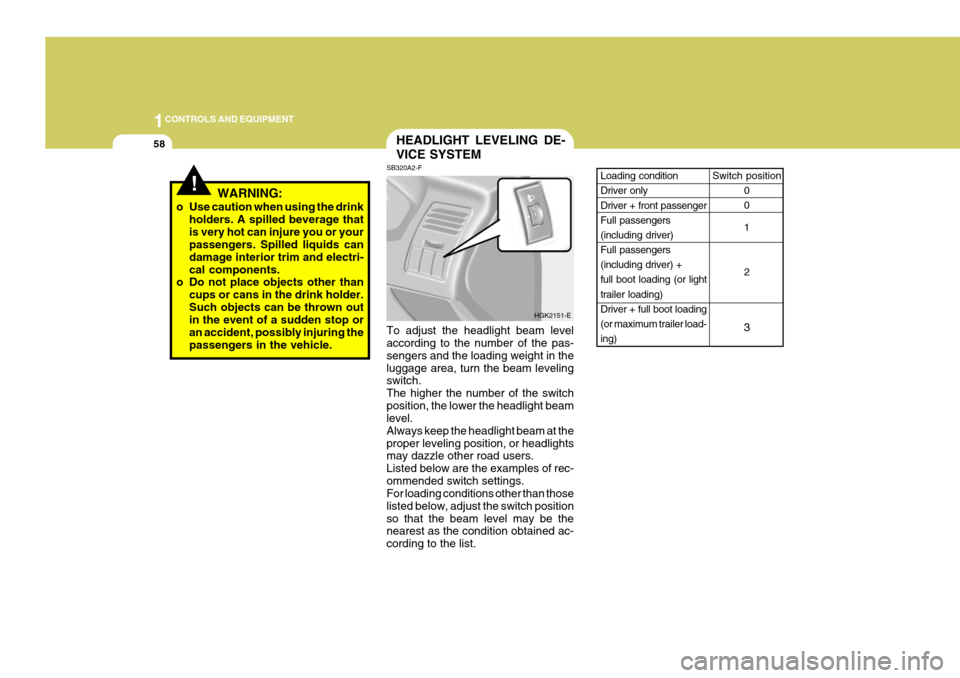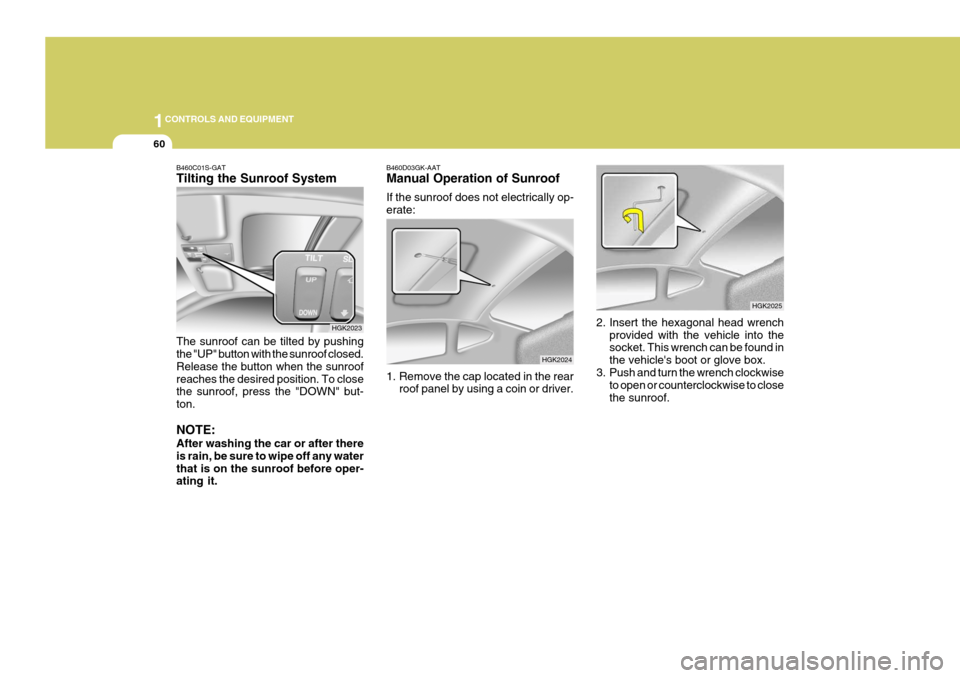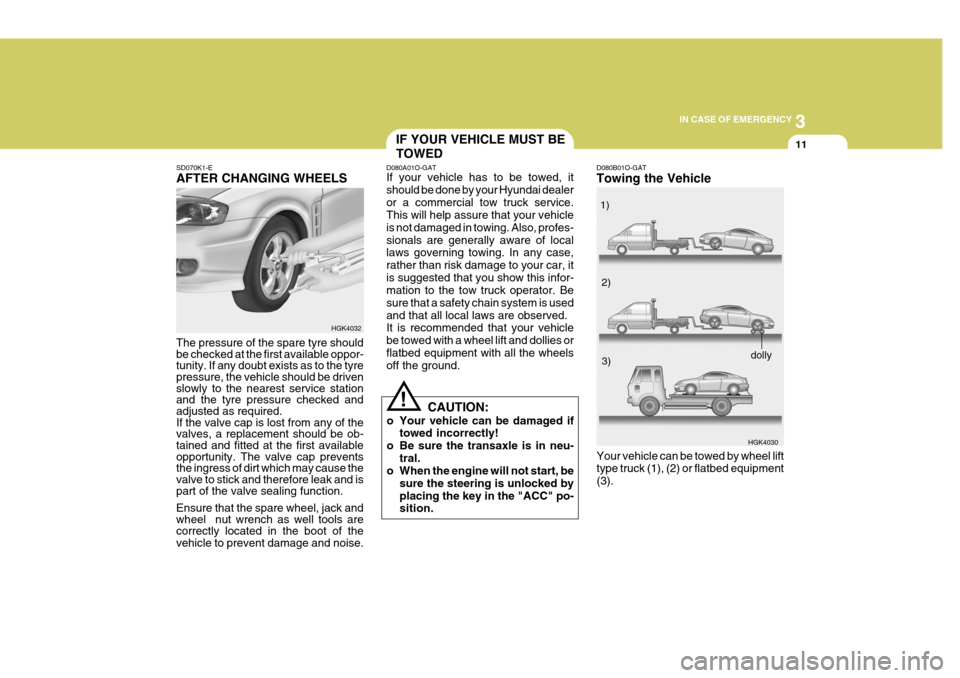2004 Hyundai Coupe boot
[x] Cancel search: bootPage 124 of 389

CORROSION PREVENTION AND APPEARANCE CARE 4-3
E030D01A-AAT When to Wax AgainYou should polish and wax the car again when water no longer beads on a clean surface butspreads out over a larger area. E030E01A-AAT Maintaining BumpersSpecial precautions must be observed to pre- serve the appearance of the bumpers on yourHyundai. They are:
o Be careful not to spill battery electrolyte or
hydraulic brake fluid on the bumpers. If you do, wash it off immediately with clear water.
o Be gentle when cleaning the bumper sur- faces. They are made of soft plastic and thesurface can be damaged if mistreated. Do notuse abrasive cleaners. Use warm water andmild soap or car-washing solution.
o Do not expose the bumpers to high tem- peratures. For example, if you have your carrepainted, do not leave the bumpers on thecar if the car is going to be placed in a high-temperature paint booth. E040A01A-AAT CLEANING THE INTERIOR To Clean the Vinyl Upholstery To clean the vinyl upholstery, first remove loose dirt and dust with a vacuum cleaner. Then applya solution of mild soap or detergent and waterusing a clean sponge or soft cloth. Allow this tostay on the surface to loosen the dirt, then wipewith a clean damp sponge or cloth. If all the dirtstains are not removed, repeat this procedureuntil the upholstery is clean. Do not use gasoline,solvent, paint thinner or other strong cleaners.
E030B01A-AAT Spot CleaningDon't use gasoline, strong solvents or corrosive cleaning agents. These can damage the finish ofthe car. To remove road tar, use turpentine on aclean, soft cloth. Be gentle.To remove dead insects or tree sap, use warmwater and mild soap or car-washing solution.Soak the spot and rub gently. If the paint has lostits luster, use a commercial car-cleaning polish. E030C01A-AAT Polishing and Waxing Always wash and dry the car before polishing or waxing or using a combination cleaner and wax.Use a good quality commercial product andfollow the manufacturer's directions on the con-tainer. Polish and wax the bright trim pieces aswell as the paint. E040B01A-AAT To Clean the Leather Upholstery (If Installed) In the normal course of use, leather upholstered surfaces will, like any material, pick-up dust anddirt. This dust and dirt must be cleaned off or itmay work into the surface of the leather, causingdamage. Fine leather needs care, and should be cleaned when necessary. Washing leather thoroughlywith soap and water will keep your leather lus-trous, beautiful and ensure you have many yearsof wear.Take a piece of cheese cloth and using any mildsoap and lukewarm water, work up a good lather.Thoroughly wash the leather. Wipe clean with aslightly damp cloth and dry with soft cloth. Do thisas often as the leather becomes soiled.
sure that the outlets and the underside of thedoors are open. Paint damage can be caused bysmall accumulation of tar, industrial precipita-tion, tree resin, insects and bird droppings, whennot removed immediately. If water alone is notstrong enough to remove the accumulated dirt,use a mild car washing solution. Be sure to rinsethe surface after washing to remove the solution.Never allow the solution to dry on the paintedsurfaces.
Page 128 of 389

VEHICLE MAINTENANCE REQUIREMENTS 5-3
GENERAL MAINTENANCE COOLING SYSTEM COOLANTMANUAL TRANSAXLE OIL AUTOMATIC TRANSAXLE FLUIDBRAKE HOSES AND LINES BRAKE FLUID REAR BRAKE DRUMS/LININGS, PARKING BRAKE BRAKE PADS, CALIPERS AND ROTORS EXHAUST PIPE AND MUFFLERSUSPENSION MOUNTING BOLTS STEERING GEAR BOX, LINKAGE & BOOTS/LOWER ARM BALL JOINT POWER STEERING PUMP, BELT AND HOSESDRIVESHAFTS AND BOOTS AIR CONDITIONING REFRIGERANT AIR CONDITIONER FILTER (FOR BLOWER UNIT)
F030C01GK-GAT
R : Replace I : Inspect and, after inspection, clean, adjust, repair or replace if necessary
120
96
I I I I II I I I I I I I I
105
84
I I I I I I I I I I I I
90 72
I I
R
I II I I I I I I I I
75 60
I I I I I I I I I I I I
60 48
I I I I II I I I I I I I I
45 36
I I I I I I I I I I I I
30 24
I I I I II I I I I I I I I
15 12
I I I I I I I I I I I I
KILOMETERS X 1000 MONTHS
NO. DESCRIPTION
1 23 4 5 6 7 8 9
10 11 1213 14 15
See Note (1)
Note : (1) FOR EVERY 24 MONTHS OR 45,000 KM, WHICHEVER OCCURS FIRST : "R" (2) FOR EVERY 12 MONTHS OR 20,000 KM, WHICHEVER OCCURS FIRST : "R"
European Community Only Except European Community
See Note (2)
Page 129 of 389

VEHICLE MAINTENANCE REQUIREMENTS
5- 4 European Community Only Except European Community
ENGINE OIL AND FILTER AIR CLEANER FILTER SPARK PLUGSTIMING BELTBRAKE PADS, CALIPERS AND ROTORSREAR BRAKE DRUMS/LININGS/PADS, PARKING BRAKESTEERING GEAR BOX, LINKAGE& BOOTS/LOWER ARM BALL JOINTDRIVESHAFTS AND BOOTSMANUAL TRANSAXLE OILAUTOMATICTRANSAXLE FLUIDAIR CONDITIONER FILTER (FOR BLOWER UNIT)
F040A03GK-GAT
MAINTENANCE UNDER SEVERE USAGE CONDITIONS
The following items must be serviced more frequently on cars normally used under severe driving conditions. Refer to the chart below for the appropriate maintenance intervals. R : Replace I : Inspect and, after inspection, clean, adjust, repair or replace if necessary
DRIVING
CONDITIONMAINTENANCE INTERVALS
R R RR
II II
RRR
MAINTENANCE
OPERATION
MAINTENANCE ITEM
EVERY 7,500 KM OR 6 MONTHS EVERY 5,000 KM OR 6 MONTHSMORE FREQUENTLYMORE FREQUENTLYEVERY 60,000 KM OR 48 MONTHSMORE FREQUENTLYMORE FREQUENTLY MORE FREQUENTLYEVERY 15,000 KM OR 12 MONTHS EVERY 100,000 KMEVERY 45,000 KMEVERY 40,000 KMMORE FREQUENTLYA, B, C, F, H C, E B, HD, E, F, GC, D, G, HC, D, G, H C, D, E, FC, D, E, F, G A, C, D, E, F, G, H, I, J A, C, E, F, G, H, IC, E
SEVERE DRIVING CONDITIONS
A - Repeated short distance driving
B - Extensive idling
C - Driving in dusty, rough roads
D - Driving in areas using salt or other corrosive materials or in very cold weather
E - Driving in sandy areas F - More than 50% driving in heavy city traffic during hot weather
above 32°C (90°F)
G - Driving in mountainous areas
H - Towing a trailer
I - Driving as a patrol car, taxi, other commercial use car or vehicle towing
J - Driving over 170 km/h1.6 DOHC/2.7 V6 2.0 DOHC CVVT
Page 131 of 389

VEHICLE MAINTENANCE REQUIREMENTS
5- 6 F070D01A-AAT
o Manual Transaxle Oil Inspect the manual transaxle oil according to
the maintenance schedule. NOTE: If the oil level is low, check for possible
leaks before adding oil. Do not overfill.
F070E02A-AAT
o Automatic Transaxle Fluid
The fluid level should be in the "HOT" range of
the dipstick, after the engine and transaxle are at normal operating temperature. Check theautomatic transaxle fluid level with the enginerunning and the transaxle in neutral, with theparking brake properly applied. Use DIAMONDATF SP- III or SK ATF SP- III when adding or
changing fluid.
F070F01A-AAT
o Brake Hoses and Lines
Visually check for proper installation, chafing,
cracks, deterioration and any leakage. Replaceany deteriorated or damaged parts immediate-ly. F070G02A-AAT
o Brake Fluid
Check brake fluid level in the brake fluid reser-
voir. The level should be between "MIN" and"MAX" marks on the side of the reservoir. Useonly hydraulic brake fluid conforming to DOT 3or DOT 4.
F070H01A-AAT
o Rear Brake Drums/Linings,
Parking Brake
Check the rear brake drums and linings for
scoring, burning, leaking fluid, broken parts,and excessive wear. Inspect the parking brakesystem including the parking brake lever andcables. For detailed service procedures, refer to the Shop Manual.
F070J01A-AAT
o Brake Pads, Calipers and Rotors Check the pads for excessive wear, discs for run out and wear, and calipers for fluid leakage. F070K01A-AAT
o Exhaust Pipe and Muffler Visually inspect the exhaust pipes, muffler and hangers for cracks, deterioration, or damage.Start the engine and listen carefully for anyexhaust gas leakage. Tighten connections orreplace parts as necessary. F070L01A-AAT o Suspension Mounting Bolts Check the suspension connections for loose- ness or damage. Retighten to the specifiedtorque. F070M01A-AAT
o Steering Gear Box, Linkage & Boots/
Lower arm Ball Joint
With the vehicle stopped and engine off, check for excessive free-play in the steering wheel.Check the linkage for bends or damage. Checkthe dust boots and ball joints for deterioration,cracks, or damage. Replace any damaged parts. F070N01A-AAT
o Power Steering Pump, Belt and
Hoses
Check the power steering pump and hoses for leakage and damage. Replace any damaged orleaking parts immediately. Inspect the powersteering belt for evidence of cuts, cracks, ex-cessive wear, oiliness and proper tension. Re-place or adjust it if necessary. F070P01A-AAT
o Driveshafts and Boots Check the drive shafts, boots and clamps for cracks, deterioration, or damage. Replace anydamaged parts and, if necessary, repack thegrease.
F070C01A-AAT
o Coolant
The coolant should be changed at the
intervals specified in the maintenance sched-ule.
Page 238 of 389

1CONTROLS AND EQUIPMENT
58
Switch position
0 0 1 2
3Loading condition Driver only Driver + front passenger Full passengers(including driver) Full passengers (including driver) +full boot loading (or light trailer loading) Driver + full boot loading(or maximum trailer load-ing)
!WARNING:
o Use caution when using the drink holders. A spilled beverage that is very hot can injure you or your passengers. Spilled liquids can damage interior trim and electri-cal components.
o Do not place objects other than
cups or cans in the drink holder.Such objects can be thrown out in the event of a sudden stop or an accident, possibly injuring thepassengers in the vehicle.
HEADLIGHT LEVELING DE- VICE SYSTEM
SB320A2-F To adjust the headlight beam level according to the number of the pas- sengers and the loading weight in theluggage area, turn the beam leveling switch. The higher the number of the switchposition, the lower the headlight beam level. Always keep the headlight beam at theproper leveling position, or headlights may dazzle other road users. Listed below are the examples of rec-ommended switch settings. For loading conditions other than those listed below, adjust the switch positionso that the beam level may be the nearest as the condition obtained ac- cording to the list. HGK2151-E
Page 240 of 389

1CONTROLS AND EQUIPMENT
60
2. Insert the hexagonal head wrenchprovided with the vehicle into the socket. This wrench can be found in the vehicle's boot or glove box.
3. Push and turn the wrench clockwise
to open or counterclockwise to closethe sunroof.
HGK2025
B460D03GK-AAT Manual Operation of Sunroof If the sunroof does not electrically op- erate:
1. Remove the cap located in the rear
roof panel by using a coin or driver.
HGK2024
B460C01S-GAT Tilting the Sunroof System The sunroof can be tilted by pushing the "UP" button with the sunroof closed. Release the button when the sunroofreaches the desired position. To close the sunroof, press the "DOWN" but- ton. NOTE: After washing the car or after there is rain, be sure to wipe off any waterthat is on the sunroof before oper- ating it.
HGK2023
Page 305 of 389

3
IN CASE OF EMERGENCY
7
D060B01GK-EAT 1. Obtain Spare Tyre and Tool Remove the spare tyre, jack and tool bag from the boot. HGK4008
HGK4009
The jack is located behind the right side of luggage trim. Remove the jackcover with screwing the bolts. Turn the jack end counterclockwise to lower the jack height by using a screw driver orwrench bar and remove it from the bracket.
Flat tyre
SD070D1-E 2. Block the Wheel Block the wheel that is diagonally op- posite from the flat tyre to prevent thevehicle from rolling when the car is raised on the jack. HGK4011
Page 309 of 389

3
IN CASE OF EMERGENCY
11
SD070K1-E AFTER CHANGING WHEELS The pressure of the spare tyre should be checked at the first available oppor-tunity. If any doubt exists as to the tyre pressure, the vehicle should be driven slowly to the nearest service stationand the tyre pressure checked and adjusted as required. If the valve cap is lost from any of thevalves, a replacement should be ob- tained and fitted at the first available opportunity. The valve cap preventsthe ingress of dirt which may cause the valve to stick and therefore leak and is part of the valve sealing function. Ensure that the spare wheel, jack and wheel nut wrench as well tools are correctly located in the boot of the vehicle to prevent damage and noise. HGK4032
IF YOUR VEHICLE MUST BE TOWED
D080A01O-GAT If your vehicle has to be towed, it should be done by your Hyundai dealeror a commercial tow truck service. This will help assure that your vehicle is not damaged in towing. Also, profes-sionals are generally aware of local laws governing towing. In any case, rather than risk damage to your car, itis suggested that you show this infor- mation to the tow truck operator. Be sure that a safety chain system is usedand that all local laws are observed. It is recommended that your vehicle be towed with a wheel lift and dollies orflatbed equipment with all the wheels off the ground.
! CAUTION:
o Your vehicle can be damaged if towed incorrectly!
o Be sure the transaxle is in neu-
tral.
o When the engine will not start, be
sure the steering is unlocked by placing the key in the "ACC" po- sition.
D080B01O-GAT Towing the Vehicle
HGK4030
Your vehicle can be towed by wheel lift type truck (1), (2) or flatbed equipment (3). 1)
2)
3)
dolly